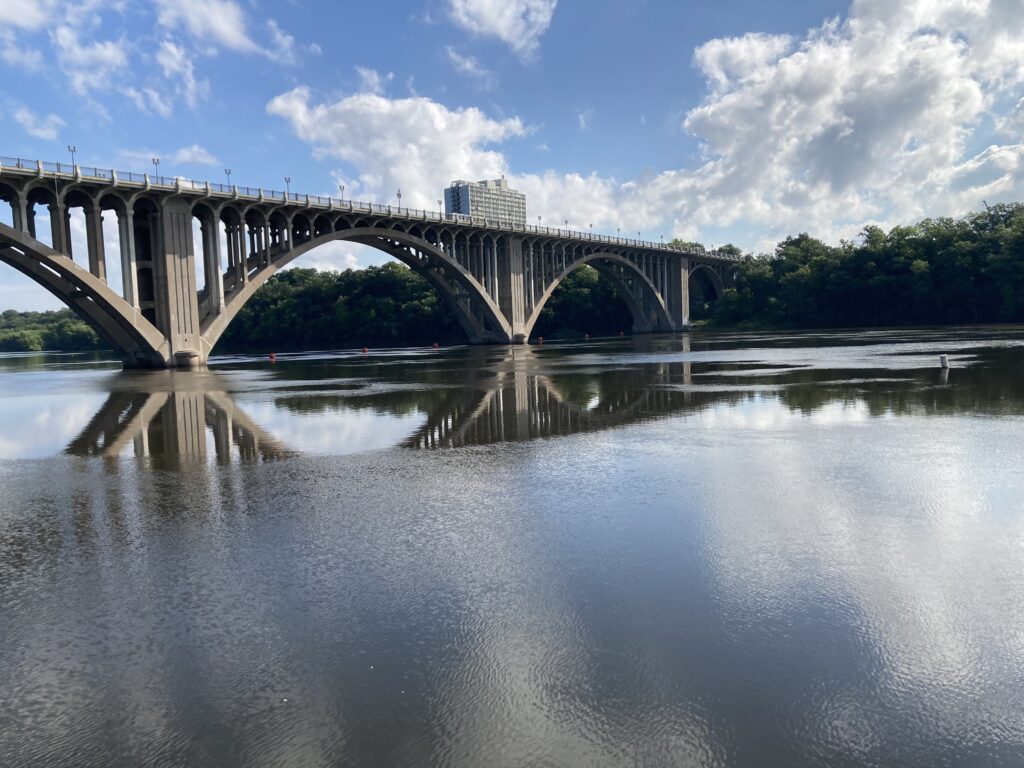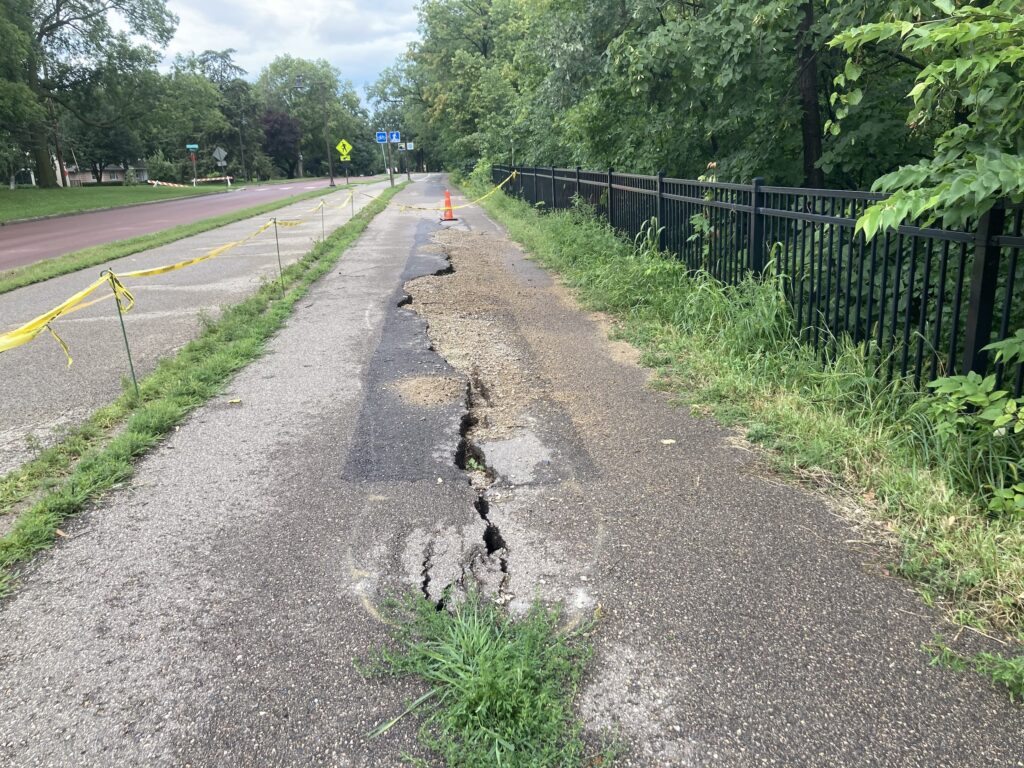60 minutes
Minnehaha Off-leash dog park
63 degrees
Wow, wow, wow! A beautiful fall hike with FWA and Delia-the-dog at the dog park. Sun, shade, a cool breeze, yellow and red leaves, sparkling water, soft sand, cute dogs, great conversations — less abstract and theoretical and more personal this time. About anxieties and social norms and traumas and friends that don’t get you.
10 Things
- soft sand
- a motor boat, floating slowly
- small stones just under the surface of the water, near the shore
- a small stretch of beach, populated by soft sand, frolicking dogs, the bones of an old tree
- a loud cry — was that human? FWA thought a kid, I wondered about a fox
- someone far off whistling badly
- the surface of the water sizzling white
- sitting on the smoothest section of a log — how many other people, and for how many years, have sat in this very spot?
- top of the limestone steps — jagged, steep
- comparing Delia’s short, quick, little steps to a much bigger dog’s loping, floating strides
GGG (girl ghost gorge), today’s update
before my hike: Reading through the last section of this collection — Air — I had some ideas about time and Endi Bogue Hartigan’s o’clock poems, specifically these lines from oh orchid o’clock:
it is morning
birds plus
socket sound of
car closing /
21st
century
pastoral
o’clock
A 21st century pastoral! Yes, I’d like to write some triple chants and offer a twist on the pastoral. The twist = critical of the romanticizing of land, of understanding land as object and background, etc. Fun!
Also, I want to write another poem — possibly a chant? — in this o’clock form that mixes my timeline with that of the gorge.
Other things yet to write: more on air in terms of lungs and breath; a looping poem using the last section of my poem, “Conservation”
anti-pastoral
I decided to start by searching for “pastoral” in my old log entries.
1 — 13 april 2021
I posted and wrote about Forrest Gander’s poem, “Pastoral.” He’s critical of the idea that we observe landscapes/land from a distance, as if seeing were a process, and not an instant act. I appreciate his challenge to the idea of distance, but don’t agree with his suggestion that seeing is instantaneous. Looking does take time to happen, for everyone.
dispossessed (not owned or occupied)
a process
encounter — a process / between two / actors / the beheld / beholder
no study, absorption
immediate, gradual
2 — 28 dec 2021
In the poem, “The Grand Scheme of Things,” Maggie Smith links the eye to the pastoral, too.
We say the naked eye
as if the eye could be clothed, as if it isn’t the world
that refuses to undress unless we turn our backs.
It shows us what it chooses, nothing more,
and it’s not waxing pastoral.
Yes! The pastoral is all about a certain understanding of sight and vision and how/what we see, how we look.
how we see / a soft sight
filtering
what is “real”?
no access / to the Truth / through our eyes
surely you/can’t imagine/the trees look/like they look/when we are/not looking (MO)
(side note: I’m realizing that the pastoral — paintings/poems — are all about how we look and see. I need to turn to this in my ekphrastic/how I see project. )
after the hike
3 — 6 feb 2022
Pastoral turns up in A Nearly Perfect Morning/ Jessica Greenbaum:
It was a nearly perfect morning—bucolic, pastoral—
bucolic: related countryside, farm fields, pastures, rural, rustic, countrified
bucolic
countrified
a plowed field
managed land
rusticate
4 — 21 march 2022
From an interview with Alice Oswald:
there’s a whole range of words that people like to use about landscape, like pastoral, idyll. I quite like taking the names away from things and seeing what they are behind their names. I exert incredible amounts of energy trying to see things from their own points of view rather than the human point of view.
…more interested in the democratic stories…the hardship of laboring, looking for food…the struggle of a tree trying to grow out of stone…always looking for that struggle. I’m allergic to peace. I like this restless landscape. I like that it won’t let you sit back and say, “what a beautiful place I’ve arrived to.” You’ve never arrived. It’s moving past you all the time.
Landscape and Literature Podcast: Alice Oswald on the Dart River
idyll = “an extremely happy, peaceful, or picturesque episode or scene, typically an idealized or unsustainable one.”
non-human / perspective
AO rejects the beautiful, as in, what a beautiful place, let me just sit and admire it! I’m thinking of 8 dec 2024, and my discussion of beauty as awe inspiring and awful, beauty as not perfect and relaxed, but pain and grief and struggle
struggling
suffering
laboring
a tree’s struggle / to make a home/ out of a stone
a river’s/fight to be free
restlessness / not relaxed
never here / always there
difficult / not easy (see 14 april 2021 and MO)
lacking peace
5 — 2 may 2022
she discusses William Blake’s poem, “The Ecchoing Green” and how the green in it is not the pastoral but the communal/village green, “where people mix with one another, young and old, playing and slowly fading, ecchoing. Green, as it echoes on the green, is the color of human community” (6)
Green Green Green
communal
village green / public space / gathering
not alone / solitude / together
echoing
mixing/ together
mingling
young and old/ animal, / mineral, / plant
6 — 21 may 2023
anti-pastoral poets
As for the pastoral poetry tradition, two poets and influences come to mind: Vievee Francis and the “anti-pastoral” poems in Forest Primeval, and Jennifer Chang’s Bread Loaf Lecture, “Other Pastorals: Writing Race and Place” (June 2019, available here.)
interview with the poet, Sarah Audsley
this is not / nostalgia. / this place has / a context, / histories / visible / and erased.
Many contemporary pastorals investigate power dynamics, status differences, and the hierarchies of classification.
Pastoral in the Back Yard (essay)
7 — 2 feb 2024
Pastorale, mentioned by Robert Fripp in a blog post about his “Quiet Moments” playlists. Ambient music, Brian Eno, music creating a space to dwell in, not a narrative. Not tightly structured, directing the eye one way, but an open field allowing the ear/the eye/the whole self to wander.
open field
opening
wandering
dwelling in / dwelling with / dwell among
solitude
8 — 24 july 2025
OED: landscape — “A view or prospect of natural inland scenery, such as can be taken in at a glance from one point of view.”
“A field is used more often to describe an area managed by people. The field before you was once an orchard and pasture belonging to a farmer. A meadow is used to describe a wild area.”
“Fields and meadows start when trees have been removed from an area. This can occur naturally with a forest fire or flood, or humans may cut down a forest. Seeds from grasses and weeds take root shortly after and a meadow is born.
As the trees within my macula disappear, my forest meadows. here I’m thinking about my classic memory from science class with the inverted tree in the back of the eye.
as the trees
within my
macula
disappear
my forest
fields and
meadows
cultivate
management
removal
forest fire
open field / empty field / unused field
no longer / occupied
—
So many great ideas from this wander through my archive!

